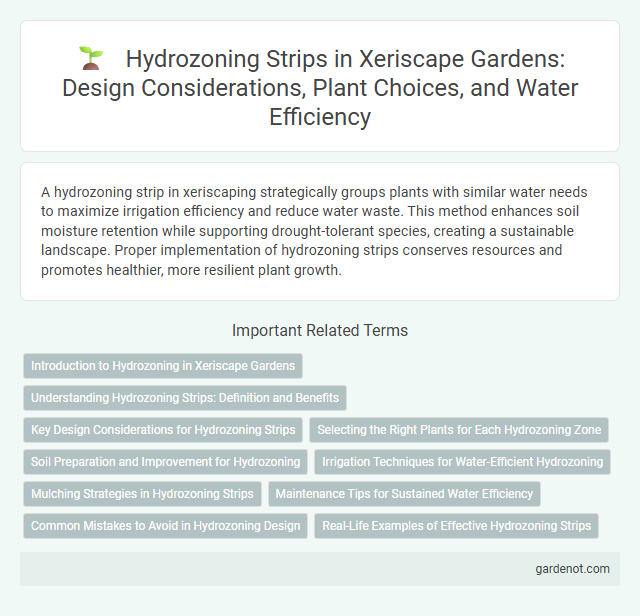A hydrozoning strip in xeriscaping strategically groups plants with similar water needs to maximize irrigation efficiency and reduce water waste. This method enhances soil moisture retention while supporting drought-tolerant species, creating a sustainable landscape. Proper implementation of hydrozoning strips conserves resources and promotes healthier, more resilient plant growth.
Introduction to Hydrozoning in Xeriscape Gardens
Hydrozoning in xeriscape gardens organizes plants with similar water requirements into designated strips, optimizing irrigation efficiency and conserving water. By grouping drought-tolerant species separately from moisture-loving plants, gardeners reduce water waste and promote healthier growth tailored to specific moisture needs. This strategic layout enhances sustainability while maintaining aesthetic appeal in xeriscape landscapes.
Understanding Hydrozoning Strips: Definition and Benefits
Hydrozoning strips refer to strategically grouping plants with similar water requirements into specific areas to maximize irrigation efficiency and minimize water waste. This landscaping technique reduces runoff and ensures that drought-tolerant plants receive limited water while high-demand plants get adequate hydration. By implementing hydrozoning strips, xeriscape designs promote sustainable water use and healthier plant growth.
Key Design Considerations for Hydrozoning Strips
Hydrozoning strips require precise soil analysis and plant water needs assessment to ensure efficient irrigation management. Selecting drought-tolerant plants grouped by similar water requirements enhances water conservation and reduces runoff. Proper strip dimensions and placement optimize soil moisture retention, aligning with xeriscape principles for sustainable landscaping.
Selecting the Right Plants for Each Hydrozoning Zone
Selecting the right plants for each hydrozoning strip is crucial for efficient xeriscape landscaping. Grouping plants with similar water requirements, such as drought-tolerant succulents in low-water zones and native grasses in moderate zones, ensures optimal irrigation management. Proper hydrozoning minimizes water waste, promotes plant health, and enhances landscape sustainability.
Soil Preparation and Improvement for Hydrozoning
Proper soil preparation and improvement are essential for effective hydrozoning in xeriscape landscaping, as they directly influence water retention and plant health. Incorporating organic matter such as compost enhances soil structure, increases moisture-holding capacity, and supports beneficial microbial activity, creating an ideal environment for drought-tolerant plants. Soil amendments like gypsum or sand can be applied to improve drainage in clay soils, ensuring optimal root growth and efficient irrigation within designated hydrozones.
Irrigation Techniques for Water-Efficient Hydrozoning
Hydrozoning strips utilize irrigation techniques that target specific plant water requirements, optimizing water use by grouping plants with similar moisture needs. Drip irrigation and micro-sprinklers deliver precise water amounts directly to the root zone, reducing evaporation and runoff. This method enhances water efficiency in xeriscape landscapes by minimizing waste and ensuring healthy plant growth.
Mulching Strategies in Hydrozoning Strips
Mulching strategies in hydrozoning strips play a crucial role in conserving soil moisture and reducing irrigation needs in xeriscape design. Organic mulches such as bark, wood chips, or composted leaves enhance water retention, regulate soil temperature, and suppress weed growth in hydrozoned areas. Selecting appropriate mulch materials with high permeability ensures efficient water infiltration while supporting plant health in drought-tolerant landscapes.
Maintenance Tips for Sustained Water Efficiency
Hydrozoning strips require regular monitoring to maintain soil moisture and prevent water waste by grouping plants with similar water needs together. Implementing drip irrigation systems and adjusting watering schedules seasonally can enhance water efficiency and reduce runoff. Periodic mulching helps retain soil moisture, suppress weeds, and supports long-term xeriscape sustainability.
Common Mistakes to Avoid in Hydrozoning Design
Common mistakes in hydrozoning design include grouping plants with differing water needs together, leading to inefficient irrigation and plant stress. Overlooking soil type variations within hydrozones can result in uneven moisture distribution and water runoff. Failing to account for microclimates such as sun exposure and wind patterns reduces the effectiveness of water conservation efforts in xeriscaping.
Real-Life Examples of Effective Hydrozoning Strips
Hydrozoning strips effectively conserve water by grouping plants with similar irrigation needs, such as drought-tolerant succulents adjacent to native grasses. A notable example includes Scottsdale, Arizona's municipal parks that utilize hydrozoning strips to reduce water consumption by over 30%. This strategic design minimizes runoff and enhances plant health in arid landscapes.
Hydrozoning strip Infographic

 gardenot.com
gardenot.com